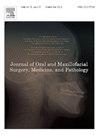评估单皮质和双皮质下颌骨冠状缺损的病理性骨折风险和残余骨高度:三维有限元分析
IF 0.4
Q4 DENTISTRY, ORAL SURGERY & MEDICINE
Journal of Oral and Maxillofacial Surgery Medicine and Pathology
Pub Date : 2024-08-16
DOI:10.1016/j.ajoms.2024.08.013
引用次数: 0
摘要
目的下颌骨缺损是一个常见的问题,也是一个难以处理的问题。缺损区域大多会自行愈合。文献中并没有明确的方案说明何时让缺损区域自发愈合,或使用钢板、螺钉、移植物等材料进行支撑,尤其是对于中等大小的缺损。本研究旨在通过检查咀嚼力导致的应力集中在下颌骨的哪些部位,以及中等大小的单皮质和双皮质缺损发生骨折的风险。在前磨牙前侧和前磨牙缺损侧应用了两种不同的加载情况。结果研究发现,在单皮质和双皮质模型中,缺损的颊前侧都有较高的应力累积,最大的应力集中在颊角。在加载 1 条件下,残余骨高度为 10 毫米的双皮质缺损的应力累积略高于单皮质缺损,而残余骨高度为 8 毫米和 6 毫米的双皮质缺损的应力值明显更高。在加载 2 条件下,双皮质缺损的应力累积高于单皮质缺损,残余骨高度为 6 毫米的双皮质缺损的应力值几乎是单皮质缺损的两倍。在两种载荷下,双皮质缺损的 Pmax 应力值都较高,尤其是当残余骨高度降低时。在两种加载条件下,单皮质缺损的 Pmin 应力值相当,但双皮质缺损的 Pmin 应力值更高,尤其是在残余骨高度为 6 毫米时。在这种情况下,可能需要用材料支撑以防止骨折。不过,要得出明确的结论,还需要进行体内和体外研究。本文章由计算机程序翻译,如有差异,请以英文原文为准。
The evaluation of pathologic fracture risk and residual bone height in unicortical and bicortical mandibular corpus defects: A 3D finite analysis
Objective
Mandibular bone defects are a common problem and difficult to manage. A defected area mostly left to heal spontaneously. It doesn’t have a definite protocol in the literature, when the area will be left to heal spontaneously or when supported with materials such as plates, screws, grafts, especially in intermediate-sized defects. In this study, it was aimed to determine by examining the areas where the stresses due to chewing forces are concentrated on the mandible bone and the risk of fracture in intermediate size unicortical and bicortical defects.
Material and Methods
The all defect models which was the residual bone heights were 6, 8, 10 mm in mandibular corpus region were created. Two different loading scenarios were applied anterior and defected premolar side. Von Mises, Pmax and Pmin stresses in models were evaluated by three-dimensional finite element analysis method.
Results
The study found higher stress accumulation on the buccal anterior side of defects in both unicortical and bicortical models, with the most stress concentrated at the buccal corners. Under Loading 1, bicortical defects with 10 mm residual bone height showed slightly higher stress accumulations than unicortical defects, while bicortical defects with 8 and 6 mm residual bone height exhibited significantly higher stress values. Under Loading 2, stress accumulations in bicortical defects were higher than in unicortical defects, with bicortical defects at 6 mm residual bone height showing almost double the stress values. Pmax stress values were higher in bicortical defects under both loadings, especially when the residual bone height decreased. Pmin stress values were comparable in unicortical defects but were higher in bicortical defects, particularly at 6 mm residual bone height, under both loading conditions.
Conclusion
This study was presented that mandibular resistance decreases significantly when residual bone height is less than 10 mm for bicortical defects and less than 8 mm at unicortical defects. In these conditions it may need supported with materials to prevent fractures. However, in vivo and in vitro studies are necessary for definitive conclusions.
求助全文
通过发布文献求助,成功后即可免费获取论文全文。
去求助
来源期刊

Journal of Oral and Maxillofacial Surgery Medicine and Pathology
DENTISTRY, ORAL SURGERY & MEDICINE-
CiteScore
0.80
自引率
0.00%
发文量
129
审稿时长
83 days
 求助内容:
求助内容: 应助结果提醒方式:
应助结果提醒方式:


